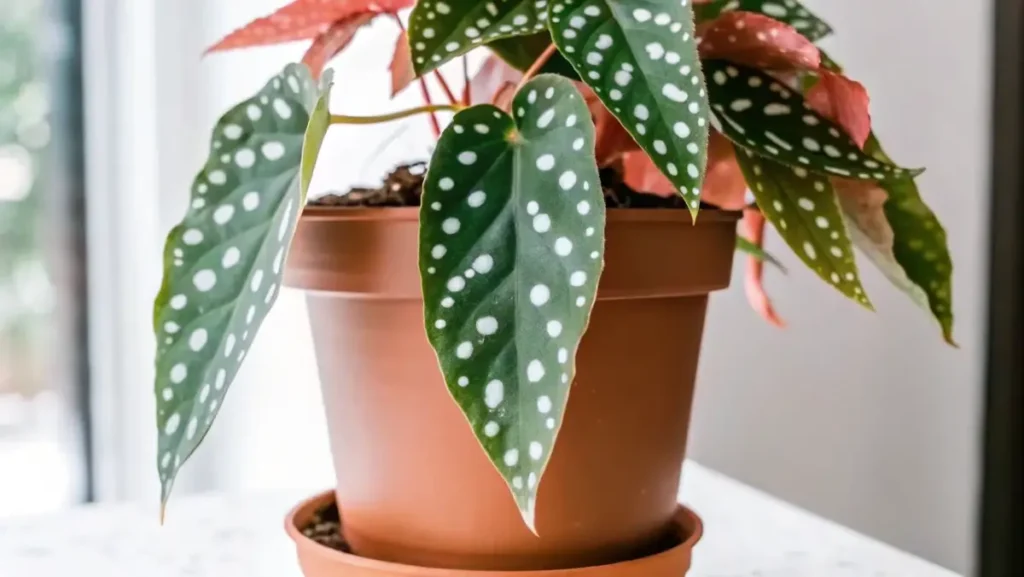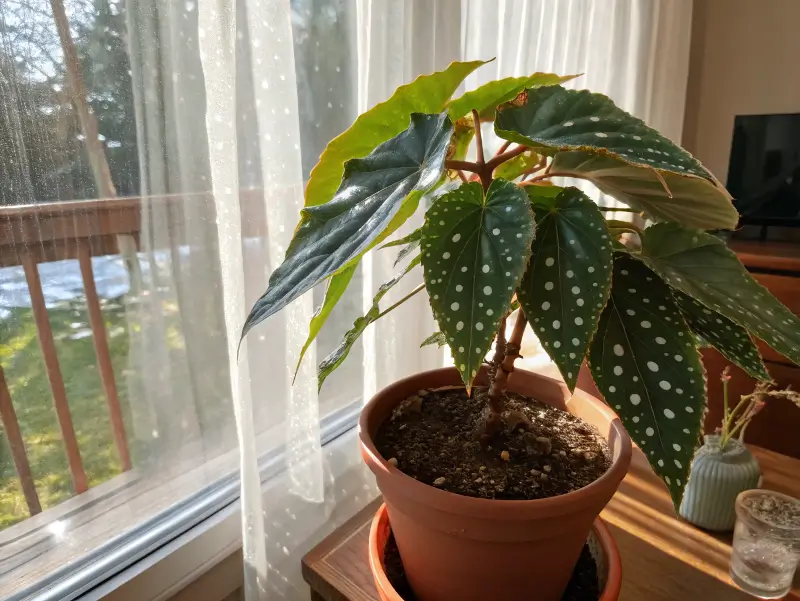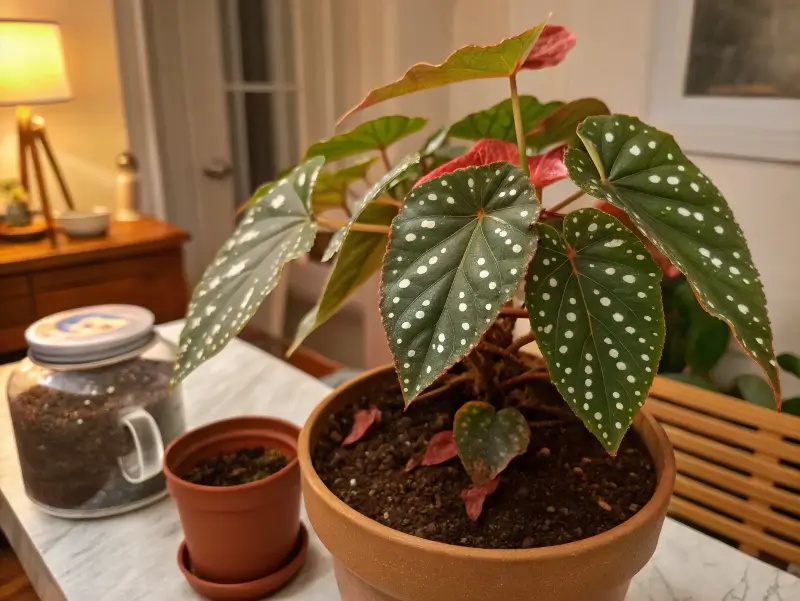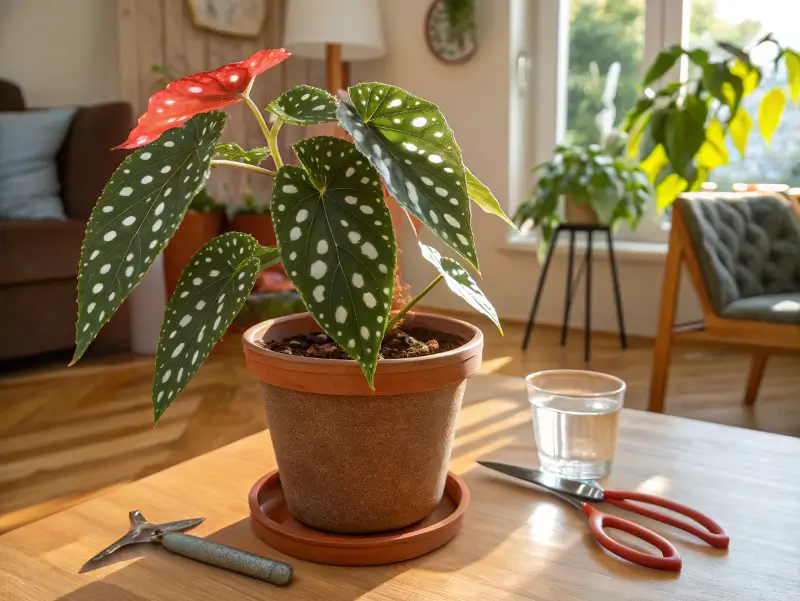
I’m thrilled to chat about the angel wing begonia today. Many people ask for tips on caring for these leafy beauties, especially when the weather swings between hot summers and chilly nights. This post covers potting, watering, display ideas, and quick fixes for plant issues. I’ll also share lessons from trial and error. If you’re aiming to jazz up indoor greenery or your porch, read on. So read on, friend!
Table of Contents
Introduction to the angel wing begonia
Origin and History of angel wing begonia
I first encountered my angel wing begonia at a local nursery one sunny afternoon. Right away, those wing-like leaves caught my attention. These plants come from the cane begonias family—yep, the ones with tall, cane-like stems. Generally, they thrive in warm places that offer moderate humidity.Fun facts:
- Part of a bigger group of foliage plants.
- Related to the polka dot begonia but with uniquely shaped leaves.
- Valued for their striking leaf patterns.
Because breeders have developed different cultivars over the years, you can pick from ones with silver spots, maroon undersides, or pinkish blooms. Each one leans toward a slightly different look, yet all share that classic wing shape.
Unique Characteristics and Leaf Structure
The angel wing begonia’s leaves often have noticeable colors—like deep green on top and red or purple on the underside. Despite being fairly easy to manage, these plants can get towering if you skip pruning.Key points to remember:
- Giant leaves with possible silver flecks.
- Upright canes reminiscent of bamboo.
- Occasionally produce bunches of flowers in pink, red, or white.
Popular Varieties of angel wing begonia
Well-Known Cultivars and Cane-Type Begonias
When I started collecting cane-type begonias, I was amazed by how many there are. A few plant parents go crazy for “Lucerna,” which produces eye-catching flowers with bright silver markings. Others prefer “Sophia” for elongated leaves and soft red undersides.Popular picks:
- “Lucerna” – famous for vibrant flowers.
- “Sophia” – slender leaves and bold colors.
- A range of unnamed hybrid cultivars in local shops.
They all fit within the cane begonia category, sharing tall stalks that can grow quite big over time.
Distinctions Between angel wing begonias and Other Begonias
Begonias come in several forms—like rhizomatous, tuberous, and rex begonias. However, the angel wing begonia usually has:
- Taller, more upright stems.
- Wing-like leaves, sometimes with spots.
- A preference for moderate to bright light, though indirect.
Polka dot begonias do have loud speckles, but the angel wing begonia leaf shape tends to be more pointed or elongated. Either way, both remain prime choices for anyone who loves showy foliage.
Ideal Growing Conditions for angel wing begonia

Balancing Sunlight and Shade for Healthy Growth
Finding that sweet spot of light can be tricky, you know? I’ve noticed that too much direct light, especially during midday, leads to leaf scorch. However, too little light can dampen its growth and limit flowering. Partial shade or bright, indirect sun usually works best.Lighting rules of thumb:
- Morning sun is often fine.
- Filter midday rays with blinds or sheer curtains.
- Watch for fading or brown tips if it’s too exposed.
Meanwhile, adjusting between slightly brighter spots and slightly shadier corners can help you see what the plant truly likes.
Soil Selection, Drainage, and pH Requirements
A well-aerated mix matters big time if you want to prevent waterlogging. I love adding a handful of perlite or coarse sand to standard potting soil. Also, keeping pH around slightly acidic helps.Soil tips:
- Opt for a mix that drains quickly.
- Add coarse sand, bark, or perlite.
- Use containers with drainage holes.
If you notice root-bound symptoms—like roots poking through the holes—you may need to repot your angel wing begonia to give it more breathing room.
Planting and Repotting Your angel wing begonia
Choosing Containers and Proper Potting Mix
Painted ceramic pots are my jam, but plastic or clay can work too. I just make sure the container isn’t too large. A small or medium size, allowing maybe an inch of space around the roots, helps avoid overwatering. You don’t want to drown your new buddy with stagnant water.Container must-haves:
- Good drainage holes.
- Enough space for roots but not too roomy.
- Possibly a shallow tray underneath to catch excess water.
The potting mix should protect against soggy soil, so I combine regular indoor mix with some perlite and coarse sand. This way, water drains properly but still keeps enough moisture for the roots.
Timing and Techniques for Repotting
I find spring is prime time for repotting because the angel wing begonia recovers well when new growth is active. Handle the root ball carefully. Trim any dead or mushy roots before placing the plant in a new pot.Repotting pointers:
- Do it at the start of the growing season.
- Loosen the root ball gently.
- Water immediately after repotting, but avoid flooding.
A quick transition period might cause brief wilting. Don’t panic—your begonia often perks up within days.
Watering and Feeding Strategy

Frequency, Methods, and Common Mistakes in Watering
I personally check the soil moisture by sticking my finger in the top inch of soil. If it’s dry, go for a watering session; if not, wait a bit longer. Overwatering is so easy to do, especially if you assume “just a bit more water can’t hurt.” Trust me, it can!Watering basics:
- Check soil before adding water.
- Avoid letting the plant sit in a water-filled saucer.
- Use room-temperature water, if possible.
In drier climates, a light misting schedule or nearby pebble tray adds some humidity. However, too much mist can cause fungal issues. When in doubt, moderation wins.
Fertilizers and Nutrient-Rich Enhancements for Vigorous Growth
For a vibrant angel wing begonia, I feed monthly with a balanced houseplant fertilizer. This helps produce those awesome leaves and maybe even some blooms.Feeding tips:
- Use a gentle, balanced formula (like 10-10-10).
- Fertilize more in spring and summer.
- Go easy if you see yellowing or crispy leaf edges.
During winter, I hold back a bit, letting the plant rest. Overdoing it can scorch the leaves, so better to feed in small amounts.
Pruning and Maintaining angel wing begonia
Encouraging Bushier Plants Through Pruning
Pruning might sound scary, but it actually boosts bushier growth. If the canes get too tall or leggy, use sharp pruning shears just above a node. This triggers new side shoots, making your plant look fuller. I’ve even made new plants from those trimmings.Pruning benefits:
- Controls the height.
- Promotes denser foliage.
- Provides fresh cuttings for propagation.
Remove dead stems or leaves when you notice them. It keeps your plant neat and stops disease from spreading.
Long-Term Maintenance Tips and Seasonal Care
Each season brings slight changes. In winter, I water less and let the angel wing begonia rest. In spring, fertilizer steps up and I might repot. Summer encourages faster growth if the plant isn’t blasted by the midday sun.Maintenance breakdown:
- Wipe leaves with a damp cloth to remove dust.
- Watch for temperature drops—anything below 60°F might shock it.
- Keep air flowing, but avoid strong drafts.
You can also pair your angel wing begonia with a Aglaonema in the same room to create a mini jungle vibe.
Troubleshooting and Common Issues (Approx. 170 words)
Pests, Diseases, and Prevention
Every so often, I fight off spider mites, aphids, or mealybugs on my plants. The angel wing begonia can get them, too. I typically catch infestations early by checking undersides of leaves. If you see any, a mild insecticidal soap usually does the trick.Key prevention tips:
- Wash leaves gently to remove dust and lurking pests.
- Quarantine infected plants until the bugs are gone.
- Provide moderate humidity to deter spider mites.
Root rot can be a problem if the soil stays waterlogged. Good drainage and mindful watering go a long way in preventing that heartbreak.
Leaf Discoloration, Droopiness, and Remedies
If leaves turn yellow or brown, it might mean either too much direct sun or inconsistent watering. Meanwhile, a droopy plant might be telling you it’s thirsty—or drowning. Quick checks:
- Touch the soil to see if it’s dry or swampy.
- Adjust your watering schedule if necessary.
- Move the plant to partial shade if the sun is harsh.
Prompt fixes avoid bigger problems, like rotting stems or widespread leaf drop.
Propagation Techniques

Stem Cutting Propagation Step-by-Step
I get pumped whenever I can turn one plant into many. Grab a healthy segment from your angel wing begonia and trim just below a leaf node. Strip the lower leaves, then place the cut end in water or a perlite-peat mix.Propagation pointers:
- Change water weekly if rooting in a jar.
- Check for new roots forming within a few weeks.
- Pot up once you see sturdy roots (about 1–2 inches long).
Honestly, watching those new roots appear is super satisfying, and it’s a chance to share your love for these plants with friends.
Leaf Cutting and Division Methods
Leaf cutting is another route, though it can be slow. You snip a healthy leaf, make small incisions around the underside veins, and place it on a damp medium. Sometimes, new baby plants form at those cut spots.Division approach:
- For bigger, older plants, gently split the root ball.
- Separate canes, ensuring each has healthy roots.
- Pot individual divisions in well-draining mixes.
This is handy if your begonia becomes crowded or if you just want more plants without waiting for stem cuttings to root.
Decorating With angel wing begonias
Indoor Placement, Terrariums, and Creative Displays
I love seeing the angel wing begonia displayed near a bright window where the leaf colors pop. Some folks put them in hanging baskets, but keep those canes supported since they can be heavy. I even pair them with a Anthurium Clarinervium in my living room. The leaf contrast looks awesome.Indoor display ideas:
- Group multiple begonias of varying heights together.
- Use a plant stand to draw the eye upward.
- Keep it away from strong air vents—drafts can stress the leaves.
Terrariums might not work for tall angel wing begonias, yet smaller seedlings can fit in a roomy, vented case if humidity is well-managed.
Outdoor Landscaping and Companion Plants
In warmer months, you can place the pot outside under partial shade. However, watch out for extreme temps. Sizzling heat can scorch leaves, while cool nights below 60°F might stunt growth. For the latest on climate considerations, I often check USDA.gov to know my hardiness zone.Outdoor tips:
- Shield the plant from harsh midday sun.
- Water more often in dry heat.
- Bring it indoors if frost is on the way.
Pair it with ferns or other shade-loving plants for a lush corner in a garden or patio.
FAQs About angel wing begonia
Do angel wing begonias like sun or shade?
It’s kinda both: indirect, bright light is ideal. A short period of morning sun is nifty, but long afternoon rays can burn the leaves.Key point: Balance is everything. If the leaves start licking up too much sun, shift them to a cooler, less intense spot.
How do I keep my angel wing begonia happy?
I personally stick to:
- A consistent watering routine.
- Regular check-ins for pests.
- Pruning to keep the shape neat.
Occasional feeding with a balanced fertilizer also results in glossier leaves and possible blooms. Basically, treat it like a friend who enjoys cozy conditions and decent lighting.
Can an angel wing begonia be planted outside?
Sure, if you live in a warm region. Some folks keep them as patio or balcony plants. Just be sure you don’t let them freeze. If nights get cold real fast, bring them in at the first sign of trouble.
Where is the best place for angel wing begonia?
I suggest a bright window protected by a sheer curtain. You might also try an east-facing porch that gives morning sun and afternoon shade. Avoid direct blasts of heat or AC. The plant wants comfortable, stable temperatures to flourish.
Bonus Tips and Final Thoughts
The angel wing begonia is honestly one of my go-to houseplants. It’s tall, it’s colorful, and it can adapt to different spaces. Just remember, though, that water management is key. Overwatering often spells disaster. Also, keep the humidity moderate. If your home is dry, a pebble tray can help.Additional pointers:
- Dust those giant leaves regularly.
- Rotate the pot every week or two for even growth.
- Snip any yellow leaves fast to redirect energy to healthy foliage.
Want a killer combo? Put your angel wing begonia next to an Aglaonema or a similar plant with contrasting leaves. You’ll create a mini tropical zone in your living room. Since I began collecting cane begonias, I’ve been hooked, and maybe you will be too. So, dig in with confidence, keep on snipping, and watch these beauties light up your space!

2 thoughts on “Angel Wing Begonia: The Ultimate Care and Growing Guide”
Comments are closed.